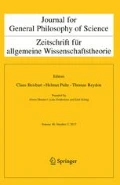Zusammenfassung
Nach vielen gegenwärtigen Wissenschaftstheoretikern ist die Wissenschaftstheorie des Logischen Empirismus, wie sie in den Schriften von Carnap, Russell, Reichenbach und Hempel vertreten wird, durch die neue Wissenschaftstheorie wesentlich verbessert worden, wie sie von Hanson, Polanyi, Toulmin und Kuhn entwickelt worden ist. Aber keiner der letzteren Gegner des Logischen Empirismus hat im Detail die Erkenntnistheorie herausgearbeitet, welche der neuen Wissenschaftstheorie zugrundeliegt. Kürzlich jedoch hat Harold I. Brown, inPerception, Theory and Commitment · The New Philosophy of Science (University of Chicago, 1979), eine klare Formulierung dieser neuen, consensualen Erkenntnistheorie vorgelegt. In dem vorliegenden Artikel entwickele und bewerte ich die Ansichten von Brown und Kuhn als Repräsentanten der neuen Erkenntnistheorie. Alles in allem begründe ich, daß die neue Erkenntnistheorie bestenfalls eine äußerst unvollständige Alternative zur logisch-empiristischen Erkenntnistheorie liefert.
Literatur
Harold I. Brown,Perception, Theory and Commitment: The New Philosophy of Science (Chicago: University of Chicago Press, 1979), Part II, especially Chapter 10.
Brown,Perception, Theory and Commitment, p. 149. Cf. Brown, “On Being Rational,”American Philosophical Quarterly 15 (October 1978), 245–46.
Thomas Kuhn, “Reflections on My Critics,” inCriticism and the Growth of Knowledge, eds. I. Lakatos and A. Musgrave (Cambridge: Cambridge University Press, 1970), p. 237. Cf. Kuhn,The Structure of Scientific Revolutions, 2d ed. (Chicago: University of Chicago Press, 1970), pp. 94, 170, 200, and Brown,Perception, Theory and Commitment, p. 150.
The present paragraph follows Kuhn, “Objectivity, Value Judgment, and Theory Choice,” inThe Essential Tension (Chicago: University of Chicago Press, 1977), p. 323. Cf. Kuhn,The Structure of Scientific Revolutions, 2d ed., pp. 184–86, 199.
Rorty, “From Epistemology to Hermeneutics,” inActa Philosophica Fennica, Vol. 30: The Logic and Epistemology of Scientific Change, eds. I. Niiniluoto and R. Tuomela (Amsterdam: North-Holland Publishing, Co., 1978), p. 20. Kuhn's writings give no reason to believe that he would disagree with the substance of this quote.
See Kuhn, “Second Thoughts on Paradigms,” inThe Essential Tension, pp. 293–319. Cf. Brown,Perception, Theory and Commitment, pp. 97–101.
This is Brown's claim inPerception, Theory and Commitment, p. 160. Cf. Kuhn, “Reflections on My Critics,” inCriticism and the Growth of Knowledge, p. 263.
Bown,Perception, Theory and Commitment, pp. 157–58.
On the ancient Babylonian astronomers see, for example, Stephen Toulmin and June Goodfield,The Fabric of the Heavens (New York: Harper & Row, 1961), pp. 23–48. Additional evidence for the variability of scientific values is available in Toulmin,Human Understanding, (Princeton: Princeton University Press, 1972), I, chapter 4, and Larry Laudan,Progress and Its Problems (Berkeley: University of California Press, 1977), chapter 4.
See Brown,Perception, Theory and Commitment, pp. 153–54, and Kuhn,The Structure of Scientific Revolutions, 2d ed., pp. 206–7.
Author information
Authors and Affiliations
Rights and permissions
About this article
Cite this article
Moser, P.K. On scientific justification by consensus. Zeitschrift für Allgemeine Wissenschaftstheorie 17, 154–161 (1986). https://doi.org/10.1007/BF01801122
Published:
Issue Date:
DOI: https://doi.org/10.1007/BF01801122

